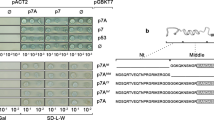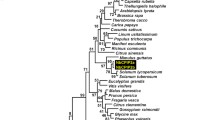Abstract
The long distance movement of potyviruses is a poorly understood step of the viral cycle. Only factors inhibiting this process, referred to as “Restricted TEV Movement” (RTM), have been identified in Arabidopsis thaliana. On the virus side, the potyvirus coat protein (CP) displays determinants required for long-distance movement and for RTM-based resistance breaking. However, the potyvirus CP was previously shown not to interact with the RTM proteins. We undertook the identification of Arabidopsis factors which directly interact with either the RTM proteins or the CP of lettuce mosaic virus (LMV). An Arabidopsis cDNA library generated from companion cells was screened with LMV CP and RTM proteins using the yeast two-hybrid system. Fourteen interacting proteins were identified. Two of them were shown to interact with CP and the RTM proteins suggesting that a multiprotein complex could be formed between the RTM proteins and virions or viral ribonucleoprotein complexes. Co-localization experiments in Nicotiana benthamiana showed that most of the viral and cellular protein pairs co-localized at the periphery of chloroplasts which suggests a putative role for plastids in this process.





Similar content being viewed by others
References
Allison RF, Dougherty WG, Parks TD, Willis J, Johnston RE, Kelly ME, Armstrong FB (1985) Biochemical analysis of the capsid protein gene and capsid protein of tobacco etch virus: N-terminal amino acids are located on the virion’s surface. Virology 147:309–316
Andersen K, Johansen IE (1998) A single conserved amino acid in the coat protein gene of pea seed-borne mosaic potyvirus modulates the ability of the virus to move systemically in Chenopodium quinoa. Virology 241:304–311
Bauer J, Chen K, Hiltbunner A, Wehrli E, Eugster M, Schnell D, Kessler F (2000) The major protein import receptor of plastids is essential for chloroplast biogenesis. Nature 403:203–207
Cayla T, Batailler B, Le Hir R, Revers F, Anstead JA, Thompson GA, Grandjean O, Dinant S (2015) Live imaging of companion cells and sieve elements in arabidopsis leaves. PLoS One 10:e0118122
Charon J, Theil S, Nicaise V, Michon T (2016) Protein intrinsic disorder within the Potyvirus genus: from proteome-wide analysis to functional annotation. Mol BioSyst 12:634–652
Chisholm J, Parra MA, Anderberg RJ, Carrington JC (2001) Arabidopsis RTM1 and RTM2 genes function in phloem to restrict long-distance movement of tobacco etch virus. Plant Physiol 127:1667–1675
Chisholm ST, Mahajan SK, Whitham SA, Yamamoto ML, Carrington JC (2000) Cloning of the Arabidopsis RTM1 gene, which controls restriction of long-distance movement of tobacco etch virus. Proc Natl Acad Sci USA 97:489–494
Chroboczek J, Hébrard E, Mäkinen K, Michon T, Rantalainen K (2012) Intrinsic disorder in genome-linked viral proteins VPgs of potyviruses. In: Uversky VN, Longhi S (eds) Flexible viruses: structural disorder in viral proteins. Wiley, Hoboken, pp 277–312
Cosson P, Sofer L, Le QH, Leger V, Schurdi-Levraud V, Whitham SA, Yamamoto ML, Gopalan S, Le Gall O, Candresse T, Carrington JC, Revers F (2010) RTM3, which controls long-distance movement of potyviruses, is a member of a new plant gene family encoding a Meprin and TRAF homology domain-containing protein. Plant Physiol 154:222–232
Cosson P, Schurdi-Levraud V, Le QH, Sicard O, Caballero M, Roux F, Le Gall O, Candresse T, Revers F (2012) The RTM resistance to potyviruses in Arabidopsis thaliana: natural variation of the RTM genes and evidence for the implication of additional genes. PLoS One 7:e39169
Decroocq V, Sicard O, Alamillo JM, Lansac M, Eyquard JP, García JA, Candresse T, Le Gall O, Revers F (2006) Multiple resistance traits control Plum pox virus infection in Arabidopsis thaliana. Mol Plant Microbe Interact 19:541–549
Decroocq V, Salvador B, Sicard O, Glasa M, Cosson P, Svanella-Dumas L, Revers F, García JA, Candresse T (2009) The Determinant of potyvirus ability to overcome the RTM resistance of Arabidopsis thaliana maps to the N-terminal region of the coat protein. Mol Plant Microbe Interact 22:1302–1311
Dolja V, Haldeman R, Robertson NL, Dougherty WG, Carrington JC (1994) Distinct functions of capsid protein in assembly and movement of tobacco etch potyvirus in plants. EMBO J 13:1482–1491
Dolja V, Haldeman-Cahill R, Montgomery AE, Vandenbosch KA, Carrington JC (1995) Capsid protein determinants involved in cell-to-cell and long distance movement of tobacco etch potyvirus. Virology 206:1007–1016
Dunoyer P, Thomas C, Harrison S, Revers F, Maule A (2004) A cysteine-rich plant protein potentiates Potyvirus movement through an interaction with the virus genome-linked protein VPg. J Virol 78:2301–2309
English JJ, Davenport GF, Elmayan T, Vaucheret H, Baulcombe DC (1997) Requirement of sense transcription for homology-dependent virus resistance and trans-inactivation. Plant J 12:597–603
Gámez-Arjona FM, de la Concepción JC, Raynaud S, Mérida Á (2014) Arabidopsis thaliana plastoglobule-associated fibrillin 1a interacts with fibrillin 1b in vivo. FEBS Lett 588:2800–2804
He Y, Chen B, Pang Q, Strul JM, Chen S (2010) Functional specification of Arabidopsis isopropylmalate isomerases in glucosinolate and leucine biosynthesis. Plant Cell Physiol 51:1480–1487
Hipper C, Brault V, Ziegler-Graff V, Revers F (2013) Viral and cellular factors involved in phloem transport of plant viruses. Front Plant Sci 4:154. doi:10.3389/fpls.2013.00154
Hruz TLO, Szabo G, Wessendorp F, Bleuler S, Oertle L, Widmayer P, Gruissem W, Zimmermann P (2008) Genevestigator V3: a reference expression database for the meta-analysis of transcriptomes. Adv Bioinform 2008:420747
Izumi M, Tsunoda H, Suzuki Y, Makino A, Ishida H (2012) RBCS1A and RBCS3B, two major members within the Arabidopsis RBCS multigene family, function to yield sufficient Rubisco content for leaf photosynthetic capacity. J Exp Bot 63:2159–2170
Karimi M, Inzé D, Depicker A (2002) GATEWAY™ vectors for Agrobacterium-mediated plant transformation. Trends Plant Sci 7:193–195
Knill T, Schuster J, Reichelt M, Gershenzon J, Binder S (2008) Arabidopsis branched-chain aminotransferase 3 functions in both amino acid and glucosinolate biosynthesis. Plant Physiol 146:1028–1039
Krause-Sakate R, Le Gall O, Fakhfakh H, Peypelut M, Marrakchi M, Varveri C, Pavan MA, Souche S, Lot H, Zerbini FM, Candresse T (2002) Molecular characterization of Lettuce mosaic virus field isolates reveals a distinct and widespread type of resistance-breaking isolate: LMV-Most. Phytopathology 92:563–572
Krichevsky A, Zaltsman A, Kozlovsky SV, Tian GW, Citovsky V (2009) Regulation of root elongation by histone acetylation in Arabidopsis. J Mol Biol 385:45–50
Ksenofontov AL, Paalme V, Arutyunyan AM, Semenyuk PI, Fedorova NV, Rumvolt R, Baratova LA, Järvekülg L, Dobrov EN (2013) Partially disordered structure in intravirus coat protein of potyvirus potato virus A. PLoS One 8:e67830
Kuusk S, Sohlberg JJ, Magnus Eklund D, Sundberg E (2006) Functionally redundant SHI family genes regulate Arabidopsis gynoecium development in a dose-dependent manner. Plant J 47:99–111
Laizet Y, Pontier D, Mache R, Kuntz M (2004) Subfamily organization and phylogenetic origin of genes encoding plastid lipid-associated proteins of the fibrillin type. J Genome Sci Technol 3:19–28
Lopez-Moya JJ, Pirone TP (1998) Charge changes near the N terminus of the coat protein of two potyviruses affect virus movement. J Gen Virol 79:161–165
Mahajan SK, Chisholm ST, Whitham SA, Carrington JC (1998) Identification and characterization of a locus (RTM1) that restricts long-distance movement of tobacco etch virus in Arabidopsis thaliana. Plant J 14:177–186
Nacir H, Bréhélin C (2013) When proteomics reveals unsuspected roles: the plastoglobule example. Front Plant Sci 4:114. doi:10.3389/fpls.2013.00114
Nicaise V, Joe A, Jeong BR, Korneli C, Boutrot F, Westedt I, Staiger D, Alfano JR, Zipfel C (2013) Pseudomonas HopU1 modulates plant immune receptor levels by blocking the interaction of their mRNAs with GRP7. EMBO J 32:701–712
Revers F, Lot H, Souche S, Le Gall O, Candresse T, Dunez J (1997) Biological and molecular variability of lettuce mosaic virus isolates. Phytopathology 87:397–403
Revers F, Yang SJ, Walter J, Souche S, Lot H, Le Gall O, Candresse T, Dunez J (1997) Comparison of the complete nucleotide sequences of two isolates of lettuce mosaic virus differing in their biological properties. Virus Res 47:167–177
Revers F, van der Vlugt RA, Souche S, Lanneau M, Lot H, Candresse T, Le Gall O (1999) Nucleotide sequence of the 3′ terminal region of the genome of four lettuce mosaic virus isolates from Greece and Yemen. Arch Virol 144:1619–1626
Revers F, Guiraud T, Houvenaghel M-C, Mauduit T, Le Gall O, Candresse T (2003) Multiple resistance phenotypes to lettuce mosaic virus among Arabidopsis thaliana accessions. Mol Plant Microbe Interact 16:608–616
Revers F, García JA (2015) Molecular biology of potyviruses. Adv Virus Res 92:101–199
Rodriguez-Medina C, Boissinot S, Chapuis S, Gereige D, Rastegar M, Erdinger M, Revers F, Ziegler-Graff V, Brault V (2015) A protein kinase binds the C-terminal domain of the readthrough protein of Turnip yellows virus and regulates virus accumulation. Virology 486:44–53
Rybicki EP, Shukla DD (1992) Coat protein phylogeny and systematics of potyviruses. In: Barnett Jr O (ed) Potyvirus taxonomy. Springer, New York, pp 139–170
Scharf K-D, Siddique M, Vierling E (2001) The expanding family of Arabidopsis thaliana small heat stress proteins and a new family of proteins containing α-crystallin domains (Acd proteins). Cell Stress Chaperones 6:225
Schuster J, Knill T, Reichelt M, Gershenzon J, Binder S (2006) BRANCHED-CHAIN AMINOTRANSFERASE4 is part of the chain elongation pathway in the biosynthesis of methionine-derived glucosinolates in Arabidopsis. Plant Cell 18:2664–2679
Seibel NM, Eljouni J, Nalaskowski MM, Hampe W (2007) Nuclear localization of enhanced green fluorescent protein homomultimers. Anal Biochem 368:95–99
Shukla DD, Strike PM, Tracy SL, Gough KH, Ward CW (1988) The N and C termini of the coat proteins of potyviruses are surface-located and the N-terminus contains the major virus-specific epitopes. J Gen Virol 69:1497–1508
Singh DK, McNellis TW (2011) Fibrillin protein function: the tip of the iceberg? Trends Plant Sci 16:432–441
Tanaka Y, Nakamura S, Kawamukai M, Koizumi N, Nakagawa T (2011) Development of a series of gateway binary vectors possessing a tunicamycin resistance gene as a marker for the transformation of Arabidopsis thaliana. Biosci Biotechnol Biochem 75:804–807
Wei T, Huang T-S, McNeil J, Laliberté J-F, Hong J, Nelson RS, Wang A (2010) Sequential recruitment of the endoplasmic reticulum and chloroplasts for plant potyvirus replication. J Virol 84:799–809
Whitham SA, Yamamoto ML, Carrington JC (1999) Selectable viruses and altered susceptibility mutants in Arabidopsis thaliana. Proc Natl Acad Sci USA 96:772–777
Whitham SA, Anderberg RJ, Chisholm ST, Carrington JC (2000) Arabidopsis RTM2 gene is necessary for specific restriction of tobacco etch virus and encodes an unusual small heat shock-like protein. Plant Cell 12:569–582
Yang Y, Sulpice R, Himmelbach A, Meinhard M, Christmann A, Grill E (2006) Fibrillin expression is regulated by abscisic acid response regulators and is involved in abscisic acid-mediated photoprotection. Proc Natl Acad Sci USA 103:6061–6066
Zhan G-M, Li R-J, Hu Z-Y, Liu J, Deng L-B, Lu S-Y, Hua W (2014) Cosuppression of RBCS3B in Arabidopsis leads to severe photoinhibition caused by ROS accumulation. Plant Cell Rep 33:1091–1108
Zhao C, Craig JC, Petzold HE, Dickerman AW, Beers EP (2005) The xylem and phloem transcriptomes from secondary tissues of the Arabidopsis root-hypocotyl. Plant Physiol 138:803–818
Acknowledgements
The authors thank Thierry Mauduit, Marylin Roncoroni and Aurélie Bailly for the production and maintenance of Arabidopsis plants, Sixue Chen (University of Florida) for the atleud1 mutant, Brigitte Batailler and Lysiane Brocard (BIC, Bordeaux) for technical help with the confocal microscopy, Valérie Nicaise (Virology team, INRA, Bordeaux) for advice with the Western blotting experiments. The microscopy was done in the Bordeaux Imaging Center, a service unit of the CNRS-INSERM and Bordeaux University, a member of the national infrastructure, France BioImaging.
Author information
Authors and Affiliations
Corresponding author
Ethics declarations
Funding
This study was funded by the French National Research Agency (ANR) in the frame of the ViroMouv project (ANR-08-GENM-016-001).
Conflict of interest
Authors declare that they have no conflict of interest.
Ethical approval
This article does not contain any studies with human participants or animals performed by any of the authors.
Electronic supplementary material
Below is the link to the electronic supplementary material.
Rights and permissions
About this article
Cite this article
Sofer, L., Cabanillas, D.G., Gayral, M. et al. Identification of host factors potentially involved in RTM-mediated resistance during potyvirus long distance movement. Arch Virol 162, 1855–1865 (2017). https://doi.org/10.1007/s00705-017-3292-6
Received:
Accepted:
Published:
Issue Date:
DOI: https://doi.org/10.1007/s00705-017-3292-6




